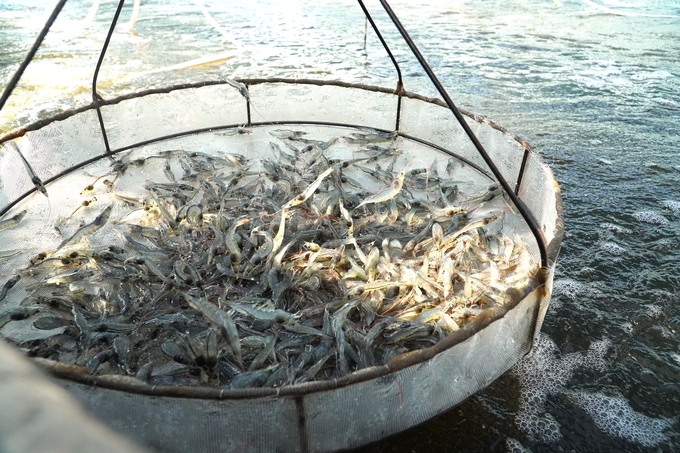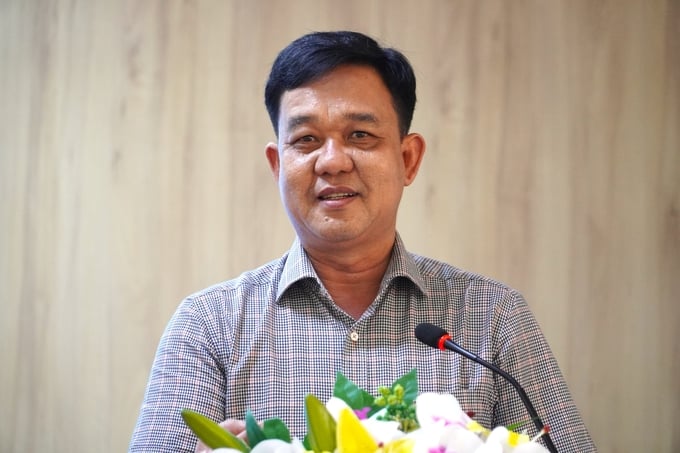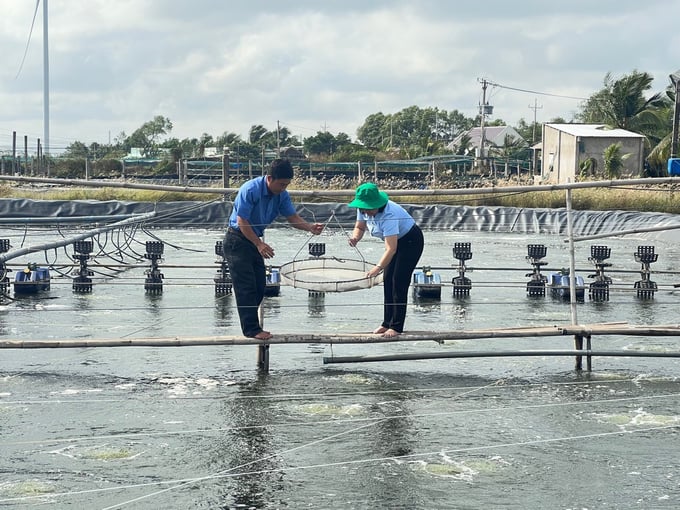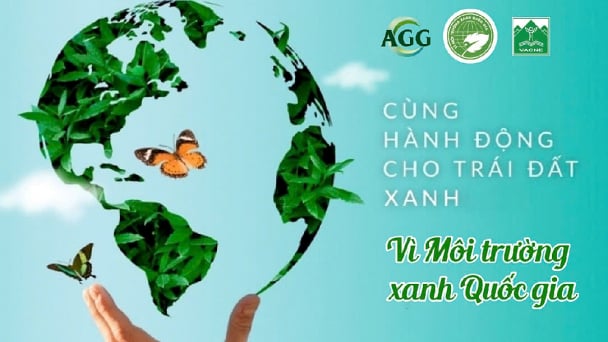May 17, 2025 | 14:18 GMT +7
May 17, 2025 | 14:18 GMT +7
Hotline: 0913.378.918
May 17, 2025 | 14:18 GMT +7
Hotline: 0913.378.918

In 2023, the Soc Trang shrimp industry aims to maintain a shrimp export turnover of approximately USD 1 billion, equivalent to 2022. Photo: Kim Anh.
Although Soc Trang province is not the capital of the shrimp industry, the province is one of the localities that makes a major contribution to Vietnam’s proportion of shrimp exports. In 2023, the Soc Trang shrimp industry aims to maintain a shrimp export turnover of approximately 1 billion USD, equivalent to 2022.
The shrimp industry in 2023 is expected to face many difficulties and challenges in terms of the consumption market due to the impact of high global inflation, reduced demand, and increased inventories. In addition, the fierce competition from low-cost rival markets made the demand for shrimp from other countries decrease in the first quarter of 2023.
In order to help the fishery production plan in 2023 be effective and close to reality to maintain growth momentum and export turnover, the Sub-Department of Fisheries (Department of Agriculture and Rural Development) of Soc Trang province has recently held a seminar on "Solutions for Selecting Good Seed, Growing in Low Salinity Conditions, and Controlling Shrimp Diseases in Hot Weather and Changing Seasons." The seminar gathered the full presence of reputable shrimp seed suppliers in the province, cooperatives, and shrimp farmers in four key localities: My Xuyen, Tran De, Vinh Chau town, and Cu Lao Dung.
Mr. Luc Thanh Tung, representative of Huy Thuan Fisheries Investment Co., Ltd., said that, currently, the success rate in shrimp farming in Vietnam reaches a low level, leading to an increase in input costs for the aquaculture ponds due to depreciation of the fixed assets such as capital, labor, electricity and water costs, seeds, etc.
Mr. Luc Thanh Tung mentioned the fact that farmers now have to pay high costs for seed investment because of intermediaries such as agents, collaborators, etc., causing a 30–40% increase in cost. Meanwhile, if the seed is transported directly from the factory to the pond, the above cost will be reduced.
"At present, in the Huy Thuan Company’s shrimp seed farming area, only approximately 20% of shrimp seeds can be sold directly to farming households; the rest must go through intermediaries, which are agents. If shrimp farmers want to earn profits, they have to improve the above issues, "said Mr. Tung.

Mr. Huynh Ngoc Nha, Director of Soc Trang Agriculture and Rural Development Department, said that cooperative groups and cooperatives play an important role in building a concentrated raw material area with production according to standards to improve the quality of products. Photo: Kim Anh.
Continuing the story of the shrimp industry, Mr. Huynh Ngoc Nha, Director of Soc Trang Agriculture and Rural Development Department, said that the market for the shrimp industry currently has many great fluctuations, especially in input products, while prices of commercial shrimp are not stable. The present price of raw white-leg shrimp seized at 50 heads/kg is VND 111,000/kg, a decrease of VND 15,000/kg compared to the beginning of the year. Shrimp with a seize of 100 heads/kg are priced at VND 91,000/kg, a reduction of VND 2,000/kg over the beginning of the year.
According to Director Huynh Ngoc Nha, the export competition between countries is very great while the production cost of 1 kilogram of shrimp in Vietnam is higher than that of some competing countries. Meanwhile, the shrimp industry accounts for about 80% of Soc Trang's export turnover.
Acknowledging that difficult situation, right from the beginning of the farming crop 2023, the Department of Agriculture and Rural Development of Soc Trang province directed specialized agencies to develop a plan for the crop 2023, with a focus on environmental monitoring to determine the suitable time for stocking shrimp, recommend suitable farming seasons for each time and farming area to minimize the risk of damage to farmers.
Controlling the value of the industry chain from product input to output is also very important. Soc Trang province has proposed many solutions to support farmers, businesses, and other entities in the industry chain. The province particularly pays attention to and promotes the role of cooperative groups and cooperatives in concentrating and cooperating in building large raw material areas with production according to safety standards (VietGAP, GlobalGAP, ASC, BAP, etc.) to improve the quality of products.

Soc Trang pays attention to shrimp production according to safety standards such as VietGAP, GlobalGAP, ASC, BAP, etc., to improve the quality of products. Photo: Kim Anh.
The Provincial Sub-Department of Fisheries also strengthens linkages with enterprises supplying input materials associated with the consumption market to reduce production costs for farmers and ensure output for products. Moreover, the industry also closely cooperates with localities in exchanging information to implement regulations on seed management. The purpose is to control the quality of shrimp seed and provide information on quality origin, etc., among seed production localities and commercial product farming localities.
The provincial agricultural sector is now deploying ten low-density shrimp farming patterns in the province, from which to promptly make evaluations on effectiveness towards dissemination and replication for shrimp farmers in the province.
In 2023, Soc Trang has planned a brackish shrimp farming area of 51,000 ha, of which 12,000 ha are prawns and 39,000 ha are white-leg shrimps. The province strives to achieve 206,700 tons of brackish shrimp production. Accordingly, as of April 24, the whole province had stocked over 13,300 ha.
Implementing Plan 107/KH-UBND dated October 9, 2018 of the Soc Trang People's Committee on the development of the Soc Trang shrimp industry by 2025, Soc Trang province promotes the building of models towards clean production and the application of high technology.
At the same time, strive to turn the province's shrimp industry into an economic spearhead that is sustainable, adapts to climate change, protects the ecological environment, and improves the quality, production efficiency, and competitiveness of Vietnamese shrimp.
Translated by Huyen Vu Thu
/2025/05/16/3923-2-171845_52.jpg)
(VAN) Lower costs, higher yields, and improved soil quality are outstanding benefits that soybeans bring when integrated into the crop rotation system.

(VAN) The 'For a Green National Environment' programme aims to promote a green lifestyle, support businesses in implementing ESG practices, and turn Net Zero commitments into concrete actions.

(VAN) Cold-barn systems efficiently manage environmental and temperature conditions, which aids in the prevention of respiratory diseases in pigs and protects them from the vectors that transmit African swine fevers.

(VAN) To tackle challenges, the project 'Addressing key technical bottlenecks in the grouper supply chain in Vietnam' has been underway since 2024.

(VAN) The project 'Disease-Resilient and Sustainable Cassava Production Systems in the Mekong Region', funded by the Australian Center for International Agricultural Research (ACIAR), is being implemented from 2024 to 2028.

(VAN) Data from 10,000 farming households will help professionalize production organization and support the implementation of the One Million Hectares Program for High-Quality, Low-Emission Rice Cultivation.

(VAN) FAO Director-General QU Dongyu marks International Day of Plant Health at NENA conference.